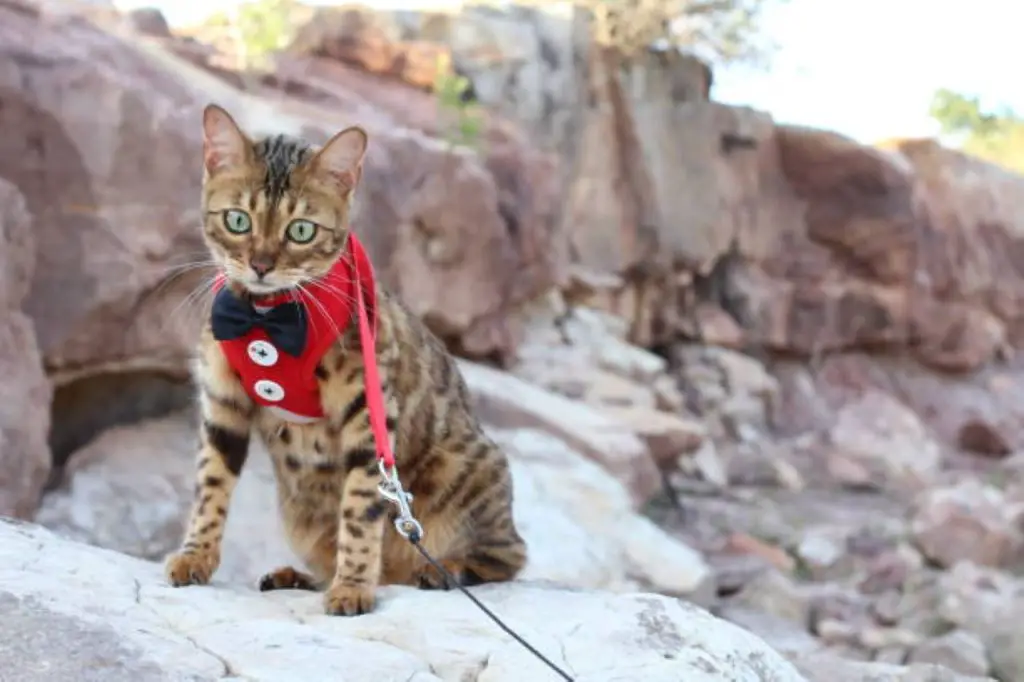
To train an adventure cat, you’ll first assess your cat’s personality traits to determine if they have the curiosity, confidence, and calmness required. Then, choose the right equipment, such as a harness with a padded chest plate and a leash with shock-absorbing features. Next, introduce the gear to your cat, starting indoors, and reward calm behavior. Begin training with short sessions, selecting quiet rooms with minimal distractions. As your cat becomes more comfortable, you can gradually move outdoors safely, teaching basic commands and recall, and building up endurance and distance – a process that requires careful planning and execution.
Table of Contents
Key Takeaways

- Assess your cat’s personality to determine suitability for outdoor adventures based on curiosity, confidence, and stress levels.
- Choose the right equipment, such as padded harnesses, shock-absorbing leashes, and safety features, to ensure comfort and safety.
- Gradually introduce your cat to gear, starting with visual and olfactory familiarization, followed by indoor training sessions.
- Start training indoors, then move to enclosed or screened-in outdoor areas, supervising your cat and inspecting for hazards.
Assess Your Cat’s Personality
Before starting outdoor adventures with your cat, you’ll need to evaluate its personality to determine whether it has the temperament and traits necessary to thrive in a harness and on a leash.
This assessment is vital, as every cat is unique, and some may not be suited for outdoor excursions.
You know your cat best, so take an objective look at its behavior and personality traits. Does it exhibit curiosity and confidence, or is it timid and easily stressed?
How does it react to new environments, people, and noises?
This post contains affiliate links. However all the information provided on this site are my own honest opinions. See more in Disclaimer.
Consider your cat’s behavior in different situations, such as during car rides, vet visits, or encounters with other animals.
A cat that remains calm and composed in these situations is more likely to adapt well to hiking and outdoor adventures.
On the other hand, if your cat becomes agitated or overwhelmed, it may be better suited for indoor activities.
By evaluating your cat’s personality traits and behavior, you can determine whether it’s a good candidate for adventure training and make informed decisions about its outdoor activities.
This will help guarantee a safe and enjoyable experience for both you and your cat.
Choose the Right Equipment

Selecting the right equipment is essential to guaranteeing a safe and enjoyable outdoor adventure with your cat, and it all starts with a well-fitting harness.
You’ll need to weigh various harness types, leash options, and safety features to guarantee your cat’s comfort and security. When choosing a harness, pay attention to sizing guidelines to ensure a snug and comfortable fit.
Here are key factors to weigh when selecting equipment for your adventure cat:
- Harnesses with padded chest plates and breathable materials for comfort and durability
- Leashes with shock-absorbing or elastic sections for reduced jerk and stress
- Safety features like quick-release buckles and reflective strips for increased visibility
- Training tools like clickers and treats to aid in the training process
Get Your Cat Used to Gear

Now that you’ve chosen the right equipment for your adventure cat, it’s time to introduce it to your cat in a gradual and controlled manner to prevent overwhelming them.
Start by letting your cat see and sniff the gear at their own pace. Place the harness, leash, or backpack in a common area where your cat spends most of their time, allowing them to become familiar with the sight, smell, and feel of the gear.
Reward your cat with treats and praise for calm behavior around the gear, using positive reinforcement to create a positive association.
As your cat becomes more comfortable with the gear’s presence, it’s time to introduce the sensation of wearing it.
Begin with short sessions, placing the harness or backpack on your cat while indoors, and reward them for remaining calm.
Gradually increase the duration and frequency of these sessions, always monitoring your cat’s comfort level and behavior. Gear familiarity is essential for a stress-free adventure, so be patient and don’t rush the process.
With consistent practice and positive reinforcement, your cat will learn to accept and even enjoy wearing their gear, setting the stage for exciting outdoor adventures together.
Start With Indoor Training
Your cat’s first experiences wearing gear should take place indoors, where they feel safest and most comfortable, to minimize stress and maximize the effectiveness of the training process.
This is also an opportunity to make indoor playtime more engaging and fun by incorporating the gear into your usual play routine.
As your cat becomes more comfortable, you can increase the duration and intensity of the indoor training sessions.
To guarantee a smooth training process, consider the following:
- Start with short sessions to prevent overwhelming your cat.
- Choose a quiet room with minimal distractions.
- Use familiar toys and treats to reinforce positive behavior.
- Practice walking your cat while they wear a harness, making it a part of the playtime experience.
Gradually Move Outdoors Safely
Once your cat appears comfortable with indoor gear training, it’s essential to introduce them to the outdoors gradually, beginning with enclosed or screened-in areas that minimize exposure to potential threats while allowing them to become accustomed to new sights, sounds, and smells.
This controlled environment will help your cat develop the confidence and skills necessary for safe outdoor exploration.
As you progress, you’ll need to take additional safety precautions to guarantee your cat’s well-being.
Always supervise your cat during outdoor excursions and be prepared to intervene if necessary.
Make sure your cat’s identification and vaccination records are up-to-date, and consider microchipping your cat for added security.
Before venturing outdoors, inspect the area for potential hazards, such as toxic plants, loose debris, or wildlife.
You should also be aware of local regulations and restrictions on outdoor cat activities.
Teach Basic Commands and Recall

To guarantee a safe and enjoyable outdoor experience with your cat, teaching basic commands and recall is essential, as it enables you to effectively communicate with your cat and promptly retrieve them if they wander off or encounter potential threats.
You’ll want to focus on positive reinforcement techniques, rewarding your cat with training treats and praise when they respond correctly.
Here are some basic commands to teach your adventure cat:
Trending in Cats:
- `Come`: This is the most critical command, as it allows you to recall your cat quickly. Use a consistent call, such as ‘kitty, come!’ and reward them with treats when they respond.
- `Stay`: This command helps your cat learn to remain calm and in place, reducing the likelihood of them darting off.
- `Leave it`: This command teaches your cat to leave potentially hazardous items alone.
- `Heel`: This command helps your cat learn to walk by your side without pulling on the leash.
Build Up Endurance and Distance

With a foundation of basic commands and recall in place, you’ll begin increasing your cat’s physical conditioning and acclimating them to wearing a harness and leash over extended periods and distances.
This is achieved through a series of endurance activities designed to gradually build up your cat’s stamina.
| Week | Endurance Activity | Distance Milestone |
|---|---|---|
| 1-2 | Short walks (5-10 minutes) | 10-20 feet |
| 3-4 | Medium walks (15-30 minutes) | 50-100 feet |
| 5-6 | Long walks (30-45 minutes) | 200-300 feet |
| 7-8 | Hill or incline walking | 300-400 feet |
| 9-10 | Off-leash training in enclosed areas | 500-600 feet |
Frequently Asked Questions
You’ll likely see behavioral changes in your cat’s indoor behavior after adventure training, requiring more indoor stimulation to prevent boredom; however, this can be managed by providing engaging activities and rotating toys regularly.
“Don’t cry over spilled milk – your older cat’s age won’t hinder training. With patience and consistency, you can still develop their adventure readiness, even if they’re no longer a spring chicken, through tailored older cat training.”
You’ll need to take essential safety measures during wildlife encounters: keep a safe distance, avoid startling animals, and consider a harness and leash for control; observe your cat’s body language and intervene if necessary to prevent conflicts.
You’re preparing your cat for outdoor excursions. Consider the case of a cat contracting rabies from a wild animal bite – a stark reminder of the importance of vaccinations. Consult with your veterinarian to create a suitable vaccination schedule.
You’re wondering if all domestic cat breeds can become adventure cats. While most breeds can adapt, some are more suited for outdoor escapades. With tailored training techniques, you can still shape your cat into a fearless adventure cat.
Conclusion on How to Train an Adventure Cat
You’ve invested time and patience into training your adventure cat, and now it’s time to reap the rewards.
Research suggests that cats can develop a strong bond with their owners through shared outdoor experiences, debunking the myth that cats are inherently solitary animals.
As you continue to challenge and engage your cat, you’ll likely see a stronger, more confident feline companion emerge, ready to take on the great outdoors by your side.












